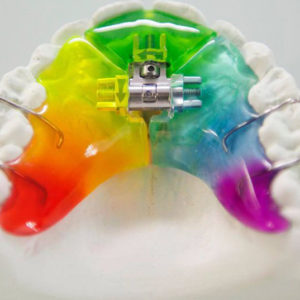Orthodontic treatment can solve a number of pathologies of dental system: align the dentition, correct an occlusion, normalize the level of the gums.
In our clinic orthodontic treatment is carried out with the help of removable orthodontic appliances:
- plates
- niotreyners (miotrayners)
- LM-activators
- easy liners
and fixed orthodontic apparatus – braces:
- metalic
- ceramic
- sapphire
We would like to tell you a little about who an orthodontist is.
The orthodontist is a dentist who specializes in eliminating anomalies of the dentoalveolar apparatus. Sometimes people think that this doctor only heals injuries, for example, jaws, but this is an erroneous opinion. Orthodontist corrects only hereditary, congenital or acquired at an early age defects.
Among the most common pathologies to be corrected by the orthodontist, we distinguish the following:
1) Incorrect bite: both in mild form and serious anomalies.
2) Non-standard arrangement of dental arches: crowding, elongation and expansion.
3) Problems with breathing.
4) Incorrect arrangement of one or more teeth.
5) Impaired chewing or speech function.
6) Unnatural shape of one or more teeth.
7) Face asymmetry.
A little earlier, we told you who the orthodontist is. And today we want to tell you what the bracket system is.
Bracket systems are orthodontic designs that are designed to align the dentition. They consist of plates that are fixed on the teeth, and the arc that connects them, which carries out the correction.
Brackets are used:
- for moving teeth
- when correcting bite anomalies
- in the presence of a gap between the teeth (the presence of diastems and three)
- in case of difficult dentition for stretching
- in the treatment of deformities of dentition resulting from tooth loss
Not so long ago we began to acquaint you with bracket systems and told what it is and when they are used.
Today, we will talk about the indications and contraindications to the use of bracket systems:
Indications for the use of bracket systems:
- Anomalies of individual teeth
- Anomalies of dentition and occlusion in the period of forming and formed permanent bite of teeth
- Preparation of the oral cavity for prosthetics
- Improved face aesthetics, profile correction
- Removal of the retouched (not cut) teeth in the dental arch
- Corpus moving of teeth
Contraindications bracket systems:
- Inadequate oral hygiene (lack of skills for double brushing of teeth)
- Presence of petioles on enamel of teeth, cracks
- Untreated tooth decay
- Multiple seals, artificial crowns
- Abuse of sugar-containing foods and drinks
- Mental diseases
- Allergy to the materials used
- Severe obscheomatichesky diseases.
From our previous posts, you already know who the orthodontist is, what braces are and in the continuation of this topic, today we want to tell you about their varieties:
Metal braces are the most durable and affordable, but well visible to other people. Treatment with metal braces is usually the fastest.
Sapphire and ceramic braces:
- Sapphires are constructed from crystals of artificial sapphires. Such braces look like precious stones, give the smile a special charm.
- Plastic braces come in different colors, even transparent. Because of their low strength, correction of the occlusion can take a little time.
- Gold braces are usually made not of pure gold, but of steel, gold is simply covered. As a rule, they do not cause allergies in the patient.
In the continuation of the topic of bracket systems, today you will learn about the types of bracket systems.
Bracket-system is of two kinds – lingual and vestibular. A distinctive feature of lingual is the way they are installed – they are not attached from the outside of the teeth, as in the case of the vestibular type of the device, but from the inside. And if, for example, sapphire or ceramic systems allow only to minimize the visibility, not to mention too noticeable metal models, the lingual braces are completely hidden. That is why they are often called invisible.
The main difference between these two systems is the complexity of their installation. While vestibular braces are fastened relatively quickly and simply, the lingual system requires considerable effort and skill. In this regard, many doctors without proper experience simply refuse to put invisibility braces, insisting on classic models. However, this does not mean that you should abandon this type of system, because everything can be solved, the main thing is to choose the ones that suit you.
We told you a lot about braces and very much hope that this information was useful to you!
At the conclusion of this topic, we want to summarize all the previously stated posts:
Braces are the most commonly used device in orthodontics for correcting curves or improperly growing teeth. These are small devices that attach to the teeth and slowly move the crooked teeth to the desired position.
There are many types of braces available these days.
The patient can choose:
- metal
- covered with silver or gold
- color brackets
- ceramic or plastic
- lingual
- Invisalign caps
Metal, ceramic or sapphire, lingual, Invisalign mouthguards. All these types of staples have their pros and cons, which must be discussed before starting treatment at the dentist and before making a decision in favor of one of them.


 Orthodontic treatment
Orthodontic treatment Attractive sides of the plate installation
Attractive sides of the plate installation Open bite
Open bite Deep bite
Deep bite